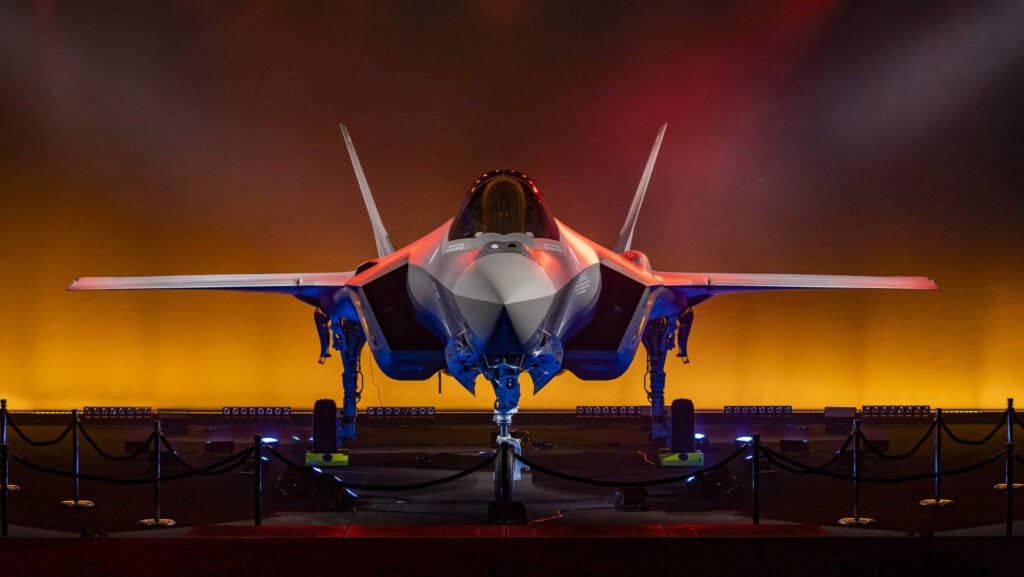The first F-35A presented to Belgium at a ceremony in Texas on Dec. 10, 2023. (Lockheed Martin)
WASHINGTON — The F-35A Joint Strike Fighter has been operationally certified to carry the B61-12 thermonuclear gravity bomb, a spokesman for the F-35 Joint Program Office (JPO) tells Breaking Defense.
In a statement, JPO spokesman Russ Goemaere said the certification was achieved Oct. 12, months ahead of a pledge to NATO allies that the process would wrap by January 2024. Certain F-35As will now be capable of carrying the B61-12, officially making the stealth fighter a “dual-capable” aircraft that can carry both conventional and nuclear weapons.
“The F-35A is the first 5th generation nuclear capable aircraft ever, and the first new platform (fighter or bomber) to achieve this status since the early 1990s. This F-35 Nuclear Certification effort culminates 10+ years of intense effort across the nuclear enterprise, which consists of 16 different government and industry stakeholders,” Goemaere said. “The F-35A achieved Nuclear Certification ahead of schedule, providing US and NATO with a critical capability that supports US extended deterrence commitments earlier than anticipated.”
Responding to follow-up questions from Breaking Defense, Goemaere said US disclosure policy prohibits the release of information on dual-capable aircraft among NATO partners. According to analysis by the Federation of American Scientists, as of 2023 approximately 100 older variants of B61 bombs are housed by NATO allies Belgium, Germany, Italy, the Netherlands and Turkey, who share the alliance’s nuclear strike mission. The first four nations are all planned F-35 operators, with the need to have a nuclear-capable aircraft a key reason for Germany signing onto the program.
The F-35A is certified to only carry the newer B61-12 variant, which will replace the older models. The certification additionally does not extend to the stealth jet’s sister variants, the short takeoff and vertical landing F-35B and carrier-launched F-35C. A delivery schedule of B61-12s to Europe is not clear, though Politico previously reported the bombs would be shipped out starting in December 2022.
“The F-35 is the world’s only 5th Generation multi-role stealth fighter, and in partnership with our customers, we continue to make advancements to ensure it stays ahead of threats,” F-35 manufacturer Lockheed Martin said in a statement.
A spokesperson for the US Air Force Air Combat Command told Breaking Defense that “all F-35As in the Air Force inventory are expected to be in a nuclear certified configuration in the future, independent of their assigned lot number,” but declined to elaborate on operational details. Goemaere explained that “USAF F-35As at designated units only are both design and operationally certified to carry the B61-12.”
An Air Force spokesperson additionally told Breaking Defense that “the B61-12 is compatible with any DCA [dual-capable aircraft] certified F-35,” and that the fighter’s suite of upgrades collectively known as Block 4 are not a requirement to use the weapon.
The F-15E was previously the first American fighter shown to be compatible with the B61-12. Three other groups of fighters — F-16A/Bs, F-16C/Ds and the PA-200 Tornado used by some NATO countries — are also authorized to carry nuclear weapons.
The dual capable aircraft serve another element of deterrence alongside the traditional nuclear triad of bombers, submarines and land-launched ICBMs, and are seen by European nations as a key part of staving off Russian aggression. Nuclear capability for the Joint Strike Fighter comes at a critical juncture for NATO amid the war in Ukraine and Russian nuclear saber-rattling in particular.

In a photo from 2015, Tyler Keil, Sandia lead engineer for an impact test series using Sandia’s Davis gun, performs a final diagnostics check on a data recorder for an impact test on the nose assembly of a mock B61-12, mounted on an aluminum tube to replicate the body of the bomb. (Photo by Randy Montoya from the archives)
Dutch military officials appeared to previously hint at nuclear capabilities for the F-35A being rolled out in Europe, writing in a post on X in November that F-35As belonging to Amsterdam achieved “initial certification” for the role. But until now, US military officials have not confirmed the fighter was cleared to use the weapon operationally.
Hans Kristensen, director of the Nuclear Information Project with the Federation of American Scientists, noted the announcement is another milestone in America’s ongoing nuclear modernization effort.
“The stage is set for the tactical nuclear weapons upgrade in Europe with full-scale production of the B61-12 and four NATO allies and the US fighter wing at Lakenheath upgrading to operate the bomb on the F-35A,” he said.
The B61-12 is a life extension program that originated in the Obama administration and is replacing older -3, -4, -7 and -10 models. The first production unit of the B61-12 rolled out in November 2021, with production scheduled through the end of fiscal 2025. The program is estimated to cost $9.6 billion in FY22 dollars over its lifespan, although much of that cost has already been spent, according to an annual government accounting of nuclear warheads [PDF].
The Biden administration additionally announced in October that it would develop a new variant of the weapon dubbed the B61-13. The newer -13 is expected to have a yield similar to the -7, officials have said, which would roughly work out to a blast equivalent of up to 360 kilotons; however, the expectation among experts is the -13 will only be certified on bombers. The yield of the -12, by comparison, is estimated at up to 50 kilotons.
Technically, neither the B61-12 or -13 are “new” nuclear weapons that increase the stockpile, as they are taking the warheads from the older bombs and placing them in new housings.




















Discussion about this post